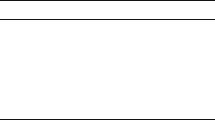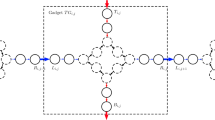Abstract
The elimination tree plays an important role in many aspects of sparse matrix factorization. The height of the elimination tree presents a rough, but usually effective, measure of the time needed to perform parallel elimination. Finding orderings that produce low elimination is therefore important. As the problem of finding minimum height elimination tree orderings is NP-hard, it is interesting to concentrate on limited classes of graphs and find minimum height elimination trees for these efficiently. In this paper, we use clique trees to find an efficient algorithm for interval graphs which make an important subclass of chordal graphs. We first illustrate this method through an algorithm that finds minimum height elimination for chordal graphs. This algorithm, although of exponential time complexity, is conceptionally simple and leads to a polynomial-time algorithm for finding minimum height elimination trees for interval graphs.
Similar content being viewed by others
References
P. A. Bernstein and N. Goodman,Power of natural semijoins, SIAM J. Comput., 10 (1981), pp. 751–771.
J. R. S. Blair and B. W. Peyton,An introduction to chordal graphs and clique trees, in George, Gilbert and Liu [11], pp. 1–30.
J. R. S. Blair and B. W. Peyton,On finding minimum-diameter clique trees, Tech. Report ORNL/TM-11850, Oak Ridge National Laboratory, Tennessee, 1991.
K. S. Booth and G. S. Lueker,Testing for the consecutive ones property, interval graphs, and graph planarity using PQ-tree algorithms, J. Comput. System Sci., 13 (1976), pp. 335–379.
J. R. Bunch and D. J. Rose, eds.,Sparse Matrix Computations, Academic Press, 1976.
E. Cuthill and J. McKee,Reducing the bandwidth of sparse symmetric matrices, in Proceedings of the 24th National Conference of the ACM, (1969), pp. 157–172.
J. S. Deogun, T. Kloks, D. Kratsch, and H. Müller,On vertex ranking for permutation and other graphs, in Proceedings of the 11th Annual Symposium on Theoretical Aspects of Computer Science, 775 (1994), pp. 747–758.
G. A. Dirac,On rigid circuit graphs, Abh. Math. Sem. Univ. Hamburg, 25 (1961), pp. 71–76.
D. R. Fulkerson and O. A. Gross,Incidence matrices and interval graphs, Pacific J. Math., 15 (1965), pp. 835–855.
F. Gavril,The intersection graphs of subtrees in trees are exactly the chordal graphs, J. Combin. Theory Ser. B, 16 (1974), pp. 47–56.
J. A. George, J. R. Gilbert, and J. W. H. Liu, eds.,Graph Theory and Sparse Matrix Computations, IMA Volumes in Mathematics and Its Applications, Springer Verlag, 1993.
P. C. Gilmore and A. J. Hoffman,A characterization of comparability graphs and of interval graphs, Canadian Journal of Mathematics, 16 (1964), pp. 539–548.
M. C. Golumbic,Algorithmic Graph Theory and Perfect Graphs, Academic Press, 1980.
F. Harary, ed.,Proof Techniques in Graph Theory, Academic Press, 1969.
P. Heggernes,Minimizing fill-in size and elimination tree height in parallel Cholesky factorization, University of Bergen, Norway, Master's thesis, 1992.
C. W. Ho and R. C. T. Lee,Counting clique trees and computing perfect elimination schemes in parallel, Information Processing Letter, 31 (1989), pp. 61–68.
J. W. H. Liu,The role of elimination trees in sparse factorization, SIAM J. Matrix Anal. Appl., 11 (1990), pp. 134–172.
F. Manne,Reducing the height of an elimination tree through local reorderings, Tech. Report 51, University of Bergen, Norway, 1991.
F. Manne,An algorithm for computing a minimum height elimination tree for a tree, Tech. Report 59, University of Bergen, Norway, 1992.
A. Pothen,The complexity of optimal elimination trees, Tech. Report CS-88-13, Pennsylvania State University, 1988.
R. E. Read, ed.,Graph Theory and Computing, Academic Press, 1972.
F. S. Roberts,Indifference graphs, in Harary [14], pp. 139–146.
D. J. Rose,A graph-theoretic study of the numerical solution of sparse positive definite systems of linear equation, in Read [21], pp. 183–217.
R. E. Tarjan,Graph theory and Gaussian elimination, in Bunch and Rose [5], pp. 3–22.
R. E. Tarjan and M. Yannakakis,Simple linear-time algorithms to test chordality of graphs, test acyclicity of hypergraphs, and selectivity reduce acyclic hypergraphs, SIAM J. Computing, 8 (1984), pp. 566–579.
M. Yannakakis,Computing the minimum fill-in is NP-complete, SIAM J. Alg. Disc. Meth., 2 (1981), pp. 77–79.
Author information
Authors and Affiliations
Additional information
This work was supported by grants from the Norwegian Research Council.
Rights and permissions
About this article
Cite this article
Aspvall, B., Heggernes, P. Finding minimum height elimination trees for interval graphs in polynomial time. BIT 34, 484–509 (1994). https://doi.org/10.1007/BF01934264
Received:
Revised:
Issue Date:
DOI: https://doi.org/10.1007/BF01934264




